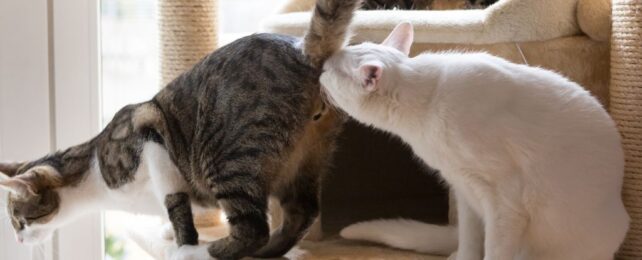Scientists at the University of California Davis are sniffing out the complex communication behind animal scent, beginning with the butts of domestic cats.
By analyzing the anal gland secretions of 23 pet cat 'participants' from the UCD veterinary medical teaching hospital, the team of researchers has shown a correlation between some types of bacteria and the synthesis of certain odorant molecules.
The findings hint at the possibility that bacteria in and around the cat anus can produce smelly volatile organic compounds (VOCs), which could convey vital information to fellow feline butt-sniffers.
In the study, led by evolutionary ecologist Connie Rojas, young and old cats showed slightly different levels of certain bacteria in their anal gland secretions, possibly because of natural changes that occur to the body or immune system with age.
While the sample size is too small to draw more links, the researchers also noticed some differences in microbial markers in the anuses of obese cats and cats that only live indoors.
At the moment, it's unclear if these are just associations, or if a cat's exposure to outdoor elements, like parasites, or its cardiovascular health somehow alter the bacterial community of its anus.
Scientists also can't be sure if these bacterial changes directly lead to functional scent changes. The researchers at UCD were only able to identify bacterial taxa or gene pathways that were potentially involved in odor production.
Far more research is needed to tie the two together, causally, and not just among domestic cats.
Smell is clearly a big part of how many animals communicate, and the way these invisible signals are sent and received represents a unique way to understand interactions of the natural world.
Nevertheless, scientists have historically overlooked the sense of smell, not just among our own species but even for extremely common and well-studied animals like birds.
Some textbooks, for instance, still claim that birds don't smell, despite recent growing research showing just how wrong that assumption is.
In 2019, a study found that symbiotic bacteria in songbirds is directly responsible for producing chemical cues (possibly to woo suitors), demonstrating a systematic causal relationship between resident bacteria and odor compounds for the first time.
The same has yet to be proved for the vast majority of other animals.
Even humans, who don't have as powerful a sense of smell as other animals, still have noses that can somehow identify available suitors or new friends. Some signs of disease in the human body are also associated with distinct smells in body odor.
The team at UCD have highlighted four bacteria for future research, as these candidates are linked to smells in the cat anal gland. The list includes Corynebacterium frankenforstense, Proteus mirabilis, Lactobacillus johnsonii, and Bacteroides fragilis.
This final bacteria was also isolated in the anal gland of a wild Bengal cat in a previous study. This past paper found that B. fragilis directly produced similar VOCs to some of those found in house cats.
The current study is small in size and did not ensure that the bacteria collected from the anal secretions of cats came specifically from the anal gland.
Nevertheless, Rojas and her colleagues say their research "fills in a large gap in the literature as only few studies have examined the microbes or metabolites in the anal glands of cats."
One day, we might even know what cats are 'saying' to each other when they expose their butts to another's nose.
The study was published in Scientific Reports.
